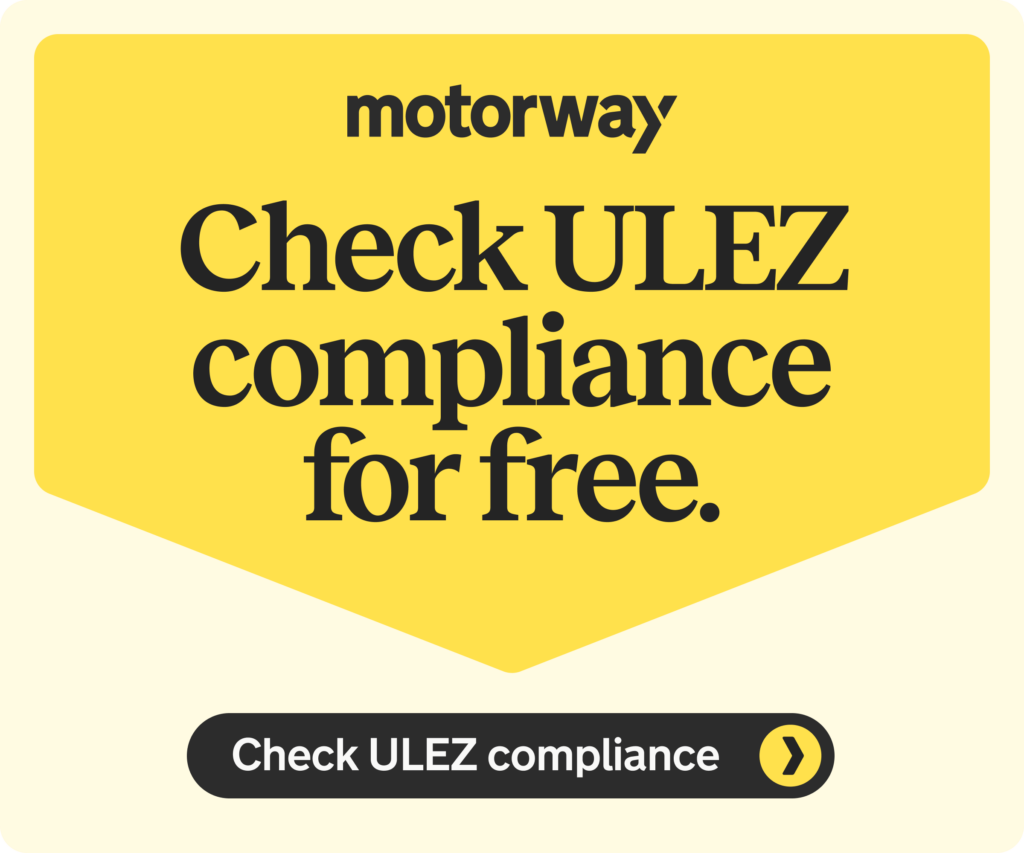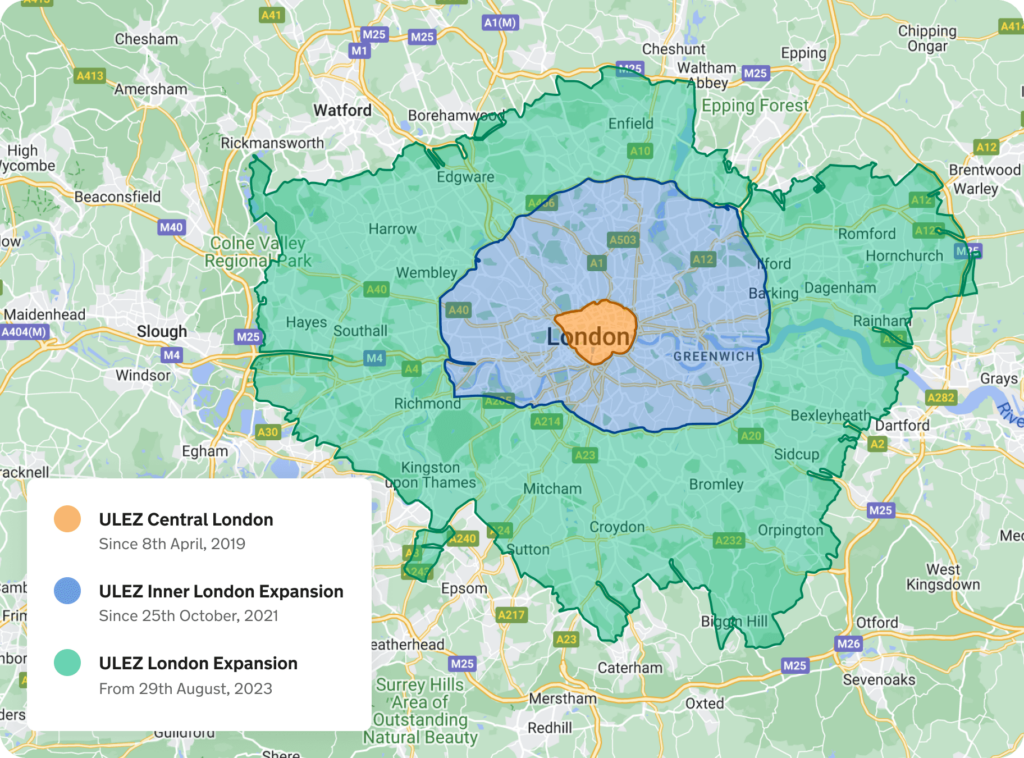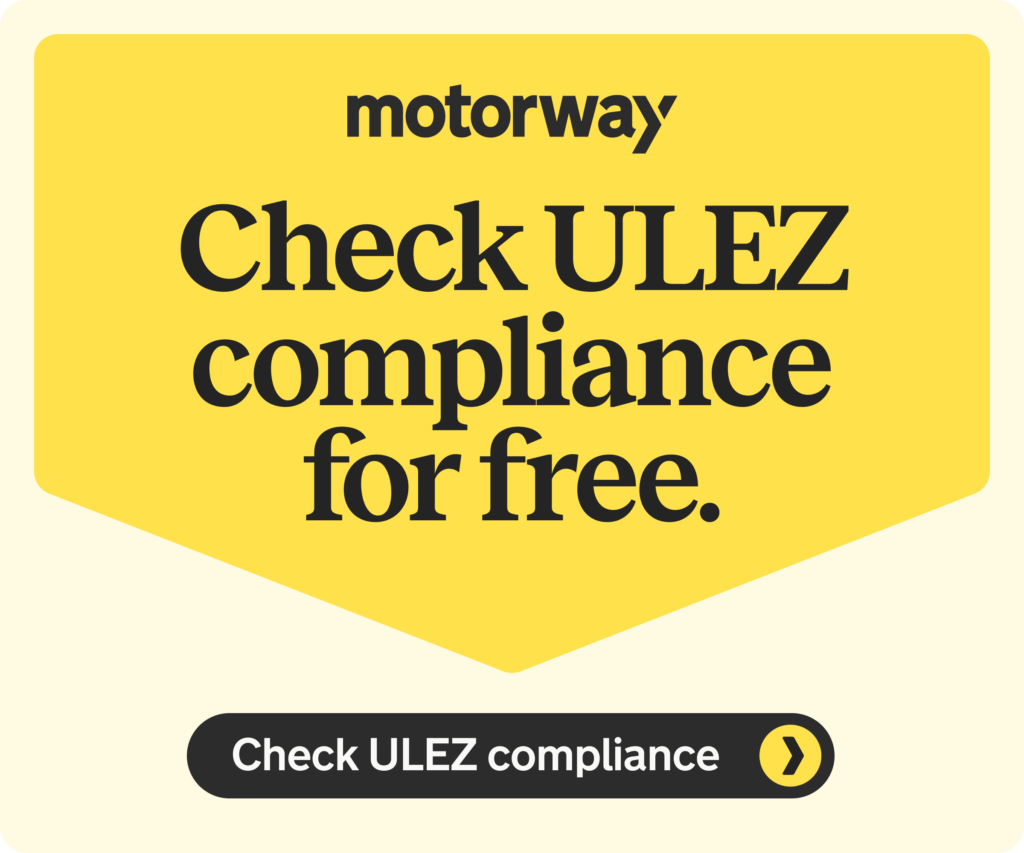If you live in or around Greater London and have a car, then you need to be aware of the Ultra Low Emission Zone (ULEZ). If you enter this area in a highly polluting vehicle, you’ll have to pay a charge, on a daily basis.
The zone was implemented in 2019, expanded in October 2021, and expanded again in August 2023. You can check your vehicle’s compliance with our free and handy tool, ULEZ Checker.
We’ve created this ultimate guide to ULEZ to help you make sense of it all. If you have a non-ULEZ compliant vehicle (e.g. a pre-2016 diesel car or pre-2006 petrol car) you may be thinking of selling to avoid charges.
Get started with selling your ULEZ-impacted vehicle, or read on for an in-depth look at London’s ULEZ policy now.

ULEZ explained:
- What is ULEZ and when did it come into force?
- ULEZ check: tool to check if your vehicle is liable for ULEZ
- ULEZ map: Where in London is the ULEZ charge enforced?
- ULEZ map 2023 – where was ULEZ expanded to?
- How much does ULEZ cost/ what is the charge?
- Which cars will be exempt from ULEZ?
- Cars to avoid buying if you travel regularly in a ULEZ zone
- ULEZ exempt cars: which one should you buy?

What is ULEZ? When did it come into force?
The aim of the world’s first Ultra Low Emission Zone (ULEZ) is to reduce pollution and improve air quality in London by introducing a charge for vehicles that don’t meet certain exhaust emission standards. The ULEZ timeline is as follows:
- The original LEZ operated from 2008, requiring Euro 3 compliance for most vehicle types. London’s LEZ is not to be confused with London’s ULEZ.
- ULEZ was announced in 2014 by the former Mayor of London at the time, Boris Johnson.
- London’s ULEZ was initiated on 8 April 2019 by Mayor Sadiq Khan, covering the same area as the Congestion Charge Zone
- Expanded in October 2021 to create a larger zone up to the North Circular Road (A406) and South Circular Road (A205).
- In January 2023, the penalty charge for failure to pay the daily ULEZ charge was raised from £160 to £180
- Since August 2023, a £160 million ULEZ scrappage scheme has been available to help residents upgrade their non-compliant vehicles – making a £2,000 grant available to households in Greater London
- ULEZ expanded again in August 2023 to cover 99% of Greater London

ULEZ checker – how do I check if my vehicle is eligible for the ULEZ charge?
For diesel cars, the ULEZ requirement is compliance with the framework of Euro 6 emissions standards. Generally, this covers cars with engines produced after 2016, but it’s important to look up the compliance of your specific car. For petrol cars, the standard required is Euro 4, and this covers most engines produced after 2006.
You can check whether your car meets the ULEZ standards using our free ULEZ checker tool.
To check if your car will need to pay a ULEZ charge in London, you’ll just need to enter your reg via the link above.

London’s Ultra Low Emission Zone charge applies to most vehicle types and includes those registered abroad. The strictest standards are for diesel engine cars – due to increasing reports of the danger of the fuel’s particulates. Any non-compliant vehicle that is not exempt from the charge will have to pay £12.50 per day to enter the zone.
The good news is that, some cars which meet the required standard have been on sale since 2001, so even certain older cars will avoid paying additional fees to travel through London.
The majority of new ‘city cars’ on the UK market at the moment will be compliant with the latest ULEZ regs.
The penalty as of January 2023 is £180 for non-compliant vehicles failing to pay the £12.50 charge. when the penalty is paid within 14 days of notice, it reduces to £90.
The ULEZ map
Before October 2021, the Ultra Low Emission Zone covered the same area as the existing London congestion charge.
The boundaries were from the A501 in the North, the A4202 in the West, and the A3204 in the South and East.

ULEZ map from 2023 – where was ULEZ expanded to?
On the 29th August 2023, ULEZ was expanded to cover Greater London, up to – but not including – the M25.
It’s estimated by TfL that 250,000 more drivers will be affected by the ULEZ expansion, and Mayor Sadiq Khan has announced a £160 million scrappage scheme making £2,000 available to all households in Greater London. For more on this support scheme, and all the changes to ULEZ in 2023, read our ultimate guide.
ULEZ charge – how much does it cost?
All vehicles pay the same charge when they don’t meet the new ULEZ emission standards, except for lorries, coaches, and similar larger vehicles.
The standard ULEZ charge for all vehicles is £12.50 per day, running from 00:00 to 23:59. It applies on every day of the year apart from Christmas Day, so if you drive into the emission zone before midnight and leave in the morning, you need to pay for both days.
If you receive a ULEZ penalty charge, the fine is £180.
When you enter the ULEZ zone, your number plate will be automatically recorded by cameras and checked to see if your vehicle complies with the emission standards.
Certain vehicles are exempt (for example, historic vehicles registered before 1973).

If you need to pay ULEZ charges, there are a number of ways to do it. The AutoPay system, first introduced for the congestion charge, can be used for ULEZ payments for up to five vehicles. This is a handy option if you or your business regularly drive within the zone.
There are no registration or renewal fees for the TfL AutoPay system and you are protected from receiving penalty charge notices while registered.
There’s also a Fleet AutoPay available for businesses using more than 5 vehicles within the zone.
You can also pay directly via either the Transport for London website or via the free TFL app.
Alternatively, you can pay by phone. The UK number is 0343 222 2222.
You’ll need to pay in advance, on the day that you drive within the ULEZ area, or the following day to avoid a penalty charge.
Which cars are exempt from ULEZ charges?
Following the Greater London expansion of the ULEZ, there are some exemptions and grace periods for certain drivers:

- Owners of registered disabled or disabled passenger vehicles will be exempt from the ULEZ charge until October 2027. The same goes for Wheelchair-Accessible Vehicles (WAVs), blue badge holders, and drivers with disabled benefits.
- Minibuses for community transport will also have a grace period until October 2025.
- London-licensed taxis are exempt from ULEZ charges.
- All vehicles registered before January 1st 1973 ( historical vehicle tax class)are exempt, including commercial use. And the rolling 40-year period for vehicles to stop paying tax will also apply to the ULEZ charge.
Read our latest guide to ULEZ exempt cars for more information.
Which cars should you avoid buying due to ULEZ charges?
The ULEZ standards for petrol cars mean that you’re likely to be exempt from charges. Petrol cars that fail the standard required by ULEZ were typically manufactured before 2005.
The Euro 4 regulations have been around for long enough that most manufacturers already meet and/or exceed them. All new cars typically meet Euro 6 standards and above, including modern hybrid models.
All fully-electric vehicles are ULEZ-compliant, as long as they can drive on electric power alone for at least 20 miles.

The cars to avoid if you live or travel into London regularly are those with diesel engines. To avoid the ULEZ charge, any diesel car needs to meet the latest Euro 6 emission limits, which came into force in September 2016.
Some older cars were produced to meet those standards, but you’ll need to check carefully, as it can be model and specification level-specific. For example, some pre-2016 BMWs do meet Euro 6 standards, but only with the optional ‘BluePerformance’ pack.
It’s worth checking specific older model cars too, as Euro 6 diesels sold before September 2016 include examples from Audi, BMW, Citroën, Mazda, Mercedes, Mini, Peugeot, Vauxhall, Volkswagen, and Volvo. So, it’s worth checking before you buy or sell your car.
If you have an electric vehicle, you’re safe from ULEZ charges and no switching will be required.
What kind of car should you buy to avoid ULEZ charges completely?
With the ULEZ expansion now in force, it’s worth thinking about how to save when you’re buying your next car. And if you already live in the Congestion Charge zone, then your resident exemption will now also have ended.
To avoid any charge in the ULEZ (and avoid the Congestion Charge at the same time), you’ll need to meet the standards, and also be capable of driving on pure electric power for at least 20 miles minimum.
Fortunately, the choice of electric cars is increasing all the time, and the price to purchase them is coming down. There are more options than ever to go electric with your car ownership, whatever your needs.
We’ve created a guide to electric cars to explain all the details about buying, selling, and living with an alternative fuel vehicle, as well as a guide exploring whether EVs are cheaper to run.
The benefit of going purely electric is that EVs are likely to be compliant with emissions regulations for longer than petrol and diesel cars, including hybrids.
For those living in the capital and surrounding area, these charges pose a legitimate problem if the combination of the Congestion Charge and ULEZ costs up to £24 per day, £720 a month, or £6,360 a year.

Selling your car?
Read about everything you need to know about how to sell your car with more guides here. There’s a lot to learn as Clean Air Zones and emissions standards in the UK change in the run-up to 2035.
- ULEZ checker – check compliance for your vehicle
- Are electric cars cheaper to run?
- Should you buy or sell a diesel car?
- Should you buy or sell a petrol car?
- Birmingham’s Clean Air Zone
- The electric vehicle (EV) switchover by 2035
- Euro 6 emissions
- The ultimate guide to electric cars
- Sell my car fast online
- Sell to a car buying site
- Car depreciation – the ultimate guide
- Hybrid cars – should you sell?
